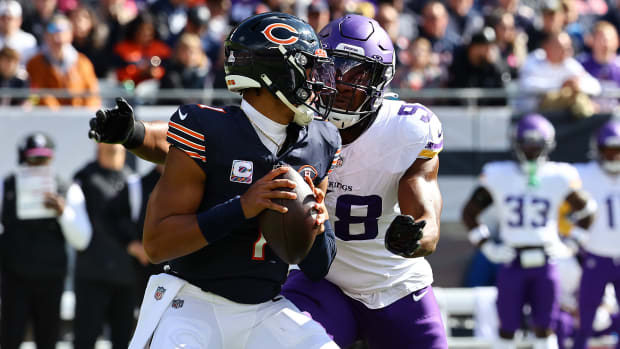Strength of Bears Schedule Tough to Gauge in Numbers
Plenty of scrutiny focused in on NFL teams' opponents once the league released its schedule, and then came the stories about strength of schedule.
Who faces the toughest schedule?
The schedules themselves mean something. Strength of schedule means zilch.
This year it means less than zilch.
It means as much as the forecasts for victory totals by sportswriters.
In fact, this year it might be the most meaningless statistic associated with analysis for the coming NFL season.
The Bears own the 13th toughest schedule in terms of last year's winning percentage. Their opponents had a .508 winning percentage. The opponents won 129, lost 125 and tied twice.
Their opponents within the NFC North had a .552 winning percentage, the ninth most severe. Opponents outside the division this year had a .481 percentage, tied for 21st most difficult.
It all means nothing mainly because you're not replaying last year's schedule against last year's opponents. Much has transpired since then and the teams on the schedule will all be different in 2020.
This happens every single year.
Here are examples.
Heading into last year the Bears faced on paper what was said to be the fifth toughest schedule. Their opponents in 2018 had a .520 winning percentage (131-121-4). When all was said and done, it turned out to be the 13th toughest schedule.
In 2018 the Bears were going to play what was said to be the fifth toughest schedule based on the previous year. Their opponents had a .520 winning percentage based on what they had done in 2017. Yet, when it was over Bears opponents owned only a .430 winning percentage. The Bears had actually played the easiest schedule in the NFL by far.
It varies so much from year to year, pinning down anything by using percentage totals based on the previous year is impossible.
Another garbage statistic is how many teams they'll play who made the playoffs last year. There are seven. What does this even mean this year when more teams actually make the playoffs than last year?
What is interesting is the personnel they'll go up against. It's just a curiosity piece more than anything else.
They're going to face the receiving leader, Michael Thomas. They will face the rushing leader, Derrick Henry. They're going to play the sacks leader, Tampa Bay's Shaq Barrett. They'll even play against the field goal leader, Josh Lambo of Jacksonville.
The winning percentage numbers mean even less than normal this year.
When you factor in the result of an offseason well out of the bounds of normalcy due to the freeze on activity resulting from coronavirus, it's impossible to determine the significance of any of those numbers.
NFL seasons can be so drastically different from one year to the next, and when you put these conditions into the mix it becomes entirely and totally unpredictable.
The best way to view it is every team in the league is facing a schedule with 16 opponents who are .500 .
Strength of Schedule Numbers
In Division
1. Arizona .688
2. Detroit .646
3. L.A. Rams .615
4. Miami .604
5. Cincinnati .583
6. Seattle .573
7. Carolina .563
N.Y. Jets .563
9. BEARS .552
10. Jacksonville .542
L.A. Chargers .542
12. San Francisco .531
13. Atlanta .521
Indianapolis .521
Tampa Bay .521
16. Minnesota .510
17. Buffalo .500
Cleveland .500
Denver .500
Las Vegas .500
21. Tennessee .479
22. Houston .458
New England .458
Pittsburgh .458
25. Green Bay .448
26. Washington .438
27. N.Y. Giants .417
28. Kansas City .396
New Orleans .396
30. Baltimore .333
31. Dallas .333
32. Philadelphia .313
Out of Division
1. Philadelphia .591
2. New England .584
3. Kansas City .563
4. Houston .553
5. New Orleans .547
6. Buffalo .541
7. Green Bay .538
8. Dallas .534
9. Atlanta .528
10. San Francisco .525
11. N.Y. Giants .522
12. Denver .519
Minnesota .519
14. N.Y. Jets .516
15. Tennessee .509
16. Baltimore .500
17. Las Vegas .494
18. Indianapolis .491
Tampa Bay .491
20. Miami .484
21. BEARS .481
Washington .481
23. Seattle .469
24. Jacksonville .466
25. Carolina .463
L.A. Chargers .463
27. L.A. Rams .456
Pittsburgh .456
29. Detroit .453
30. Cleveland .438
31. Arizona .416
32. Cincinnati .413
Overall
1. New England .537
2. N.Y. Jets .533
3. Miami .529
4. San Francisco .527
5. Atlanta .525
Buffalo .525
Detroit .525
8. Arizona .518
Houston .518
10. L.A. Rams .516
Minnesota .516
12. Denver .512
13. BEARS .508
Seattle .508
15. Green Bay .504
16. Indianapolis .502
Tampa Bay .502
18. Carolina .500
Kansas City .500
20. Tennessee .498
21. Las Vegas .496
22. Jacksonville .494
23. L.A. Chargers .492
24. New Orleans .490
25. Philadelphia .486
26. N.Y. Giants .482
27. Cincinnati .477
28. Washington .465
29. Cleveland .461
30. Dallas .459
31. Pittsburgh .457
32. Baltimore .438
Twitter: BearDigest@BearsOnMaven




